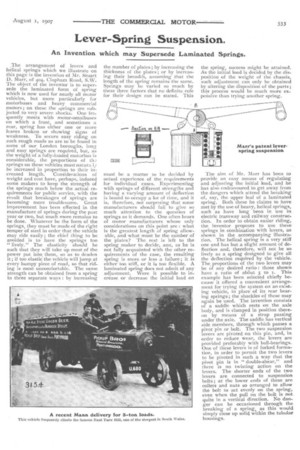Lever-Spring Suspension.
Page 21

If you've noticed an error in this article please click here to report it so we can fix it.
An Invention which may Supersede Laminated Springs.
,The arrangement of levers and helical springs which we illustrate on this page is the invention of Mr. Stuart D. Marr, of 404, Clapham Road, S.W. The object of the inventor is to supersede the laminated form of spring which is now used for nearly all motor vehicles, but more particularly for motorbuses and heavy commercial motors ; on these the springs are subjected to very severe shocks. One frequently meets with motor-omnibuses on which a front, and sometimes a rear, spring has either one or more leaves broken or showing signs of weakness. To secure easy riding on such rough roads as are to be found in some of our London boroughs, long and easy springs are required, but, as the weight of a fully-loaded motorbus is considerable, the proportions of th springs on these vehicles must natural, be increased in proportion to their increased length. Considerations of weight and cost have, perhaps, induced some makers to keep the strength of the springs much below the actual requirements for public service, with the result that breakages of springs are becoming more troublesome. Great improvement has been effected in the manufacture of springs during the past year or two, but much more remains to be done. Whatever be the form of the springs, they must be made of the right temper of steel in order that the vehicle may ride easily ; the chief thing to be avoided is to have the springs too "lively." The elasticity should be such that they will take up most of the power put into them, so as to deaden it ; if too elastic the vehicle will jump at every bumpy piece of road, so that riding is most uncomfortable. The same strength can be obtained from a spring in three separate ways : by increasing
the number of plates ; by increasing the thickness of the plates ; or by increasing their breadth, assuming that the length of the spring remains the same. Springs may be varied so much by these three factors that no definite rule for their design can be stated. This must be a matter to be decided by actual experience of the requirements for individual cases. Experimenting with springs of different strengths and having a varying amount of deflection is bound to occupy a lot of time, and it is, therefore, not surprising that some manufacturers should fail to give so much attention to the question of springs as it demands. One often hears of motor manufacturers whose only considerations on this point are : what is the greatest length of spring allowable, and what must be the camber of the plates? The rest is left to the spring maker to decide, and, as he is not fully acquainted with the other requirements of the case, the resulting spring is more or less a failure ; it is either too Stiff, or it is too flexible. A laminated spring does not admit of any adjustment. Were it possible to increase or decrease the initial load on
the spring, success might be attained. As the initial load is decided by the disposition of the weight of the chassis, such adjustment can only be obtained by altering the disposition of the parts; this process would be much more expensive than trying another spring.
The aim of Mr. Marr has been to provide an easy means of regulating and adjusting the initial load, and he has also endeavoured to get away from the dangers which attend the breaking of, say, the upper leaf of a laminated spring. Both these he Claims to have met by the use of heavy, helical springs, such as have long been in use in electric tramway and railway construction. In order to obtain easier riding, the inventor proposes to use these springs in combination with levers, as shown in the accompanying illustra tion. The helical spring is a very stiff one and has but a slight amount of de flection and, therefore, will not be so
lively as a spring designed to give all the deflection required by the vehicle.
The, proportions of the two levers may be of any desired ratio : those shown have a ratio of abut 5 to t. This example has been selected chiefly be cause it offered a convenient arrangement for trying the system on an exist ing vehiele, in place of its rear bear ing springs; the shackles of these may again be used. The invention consists of a saddle which rests on the axle body, and is clamped in position thereon by means of a strap passing under the axle. The saddle has vertical
side members, through which passes a pivot pin or bolt. The two suspension
levers are pivoted on this pin, and, in order to reduce wear, the levers are provided preferably with ball-bearings. One of these levers is of forked forma
tion, in order to permit the two levers to be pivoted in such a way that the
pivot pin is in " double-shear," and there is no twisting action on the levers. The shorter ends of the two
Levers are connected to suspension bolts ; at the lower ends of these are collets and nuts so arranged to allow the bolt to act evenly on the spring, even when the pull on the bolt is notquite in a vertical direction. No danger can be occasioned through the breaking of a spring1 as this would simply close up solid within the tubular housings.


























